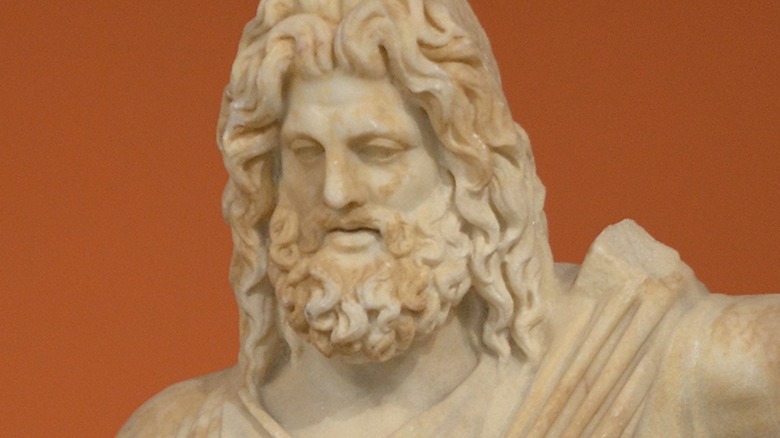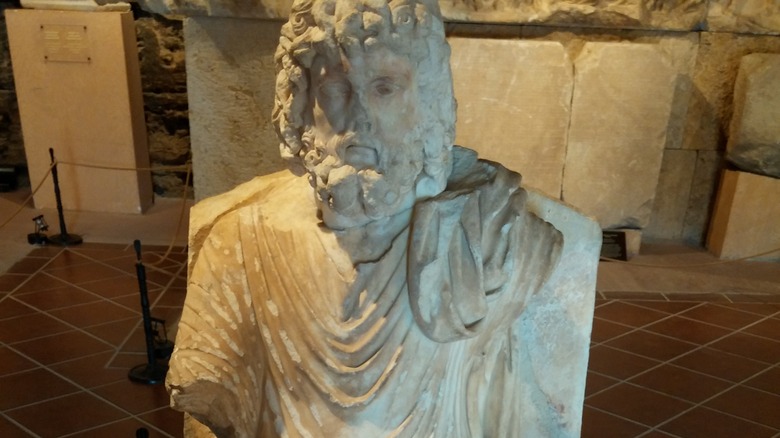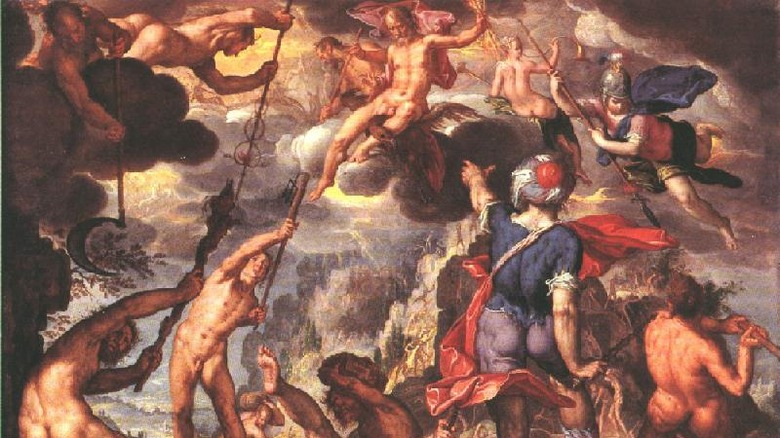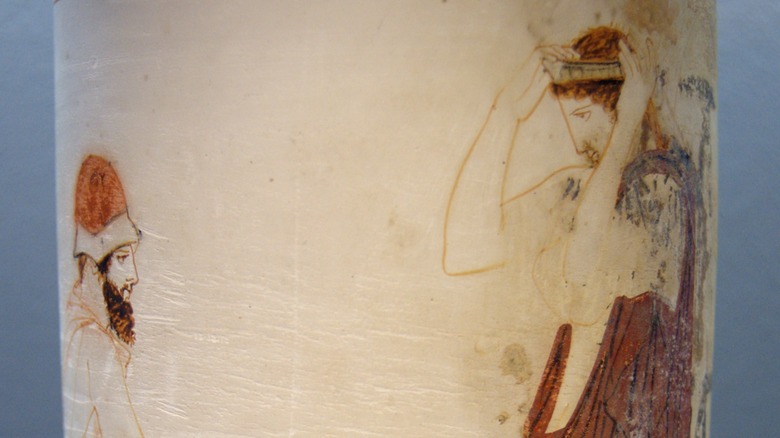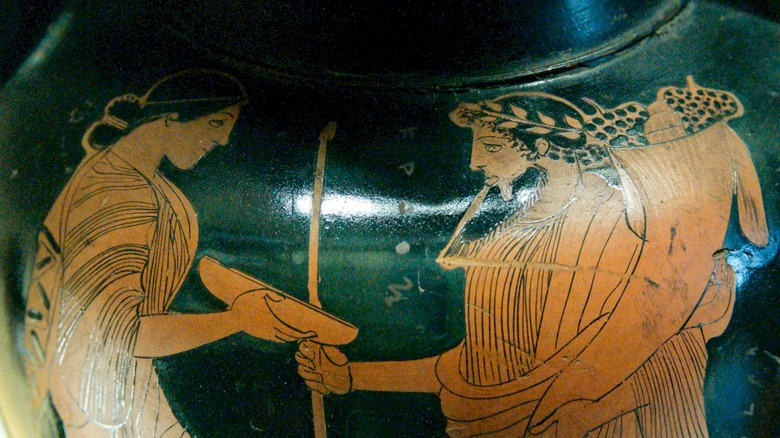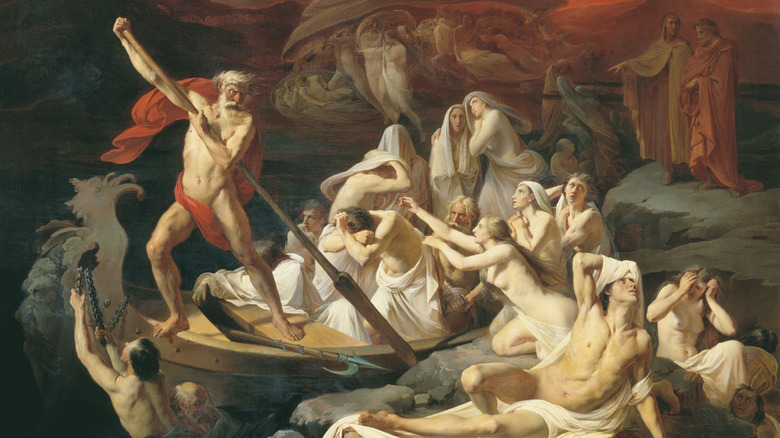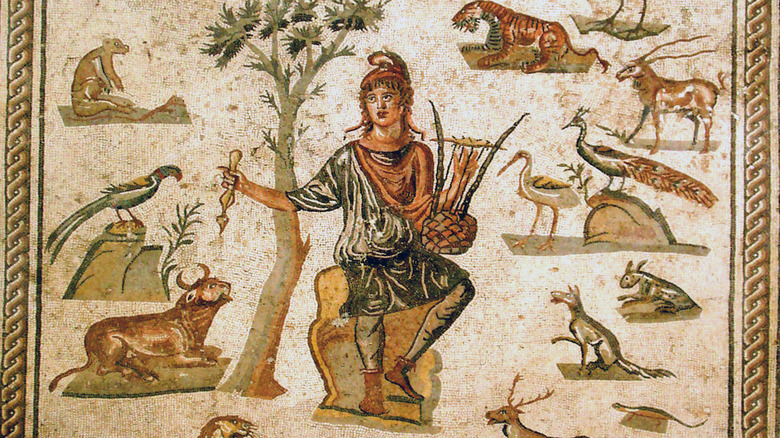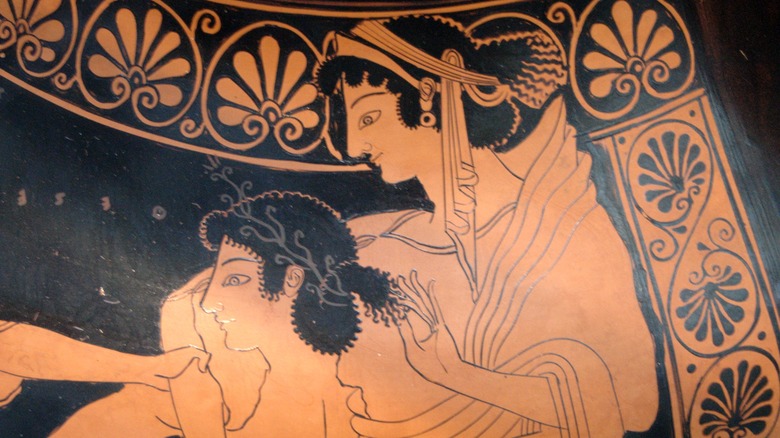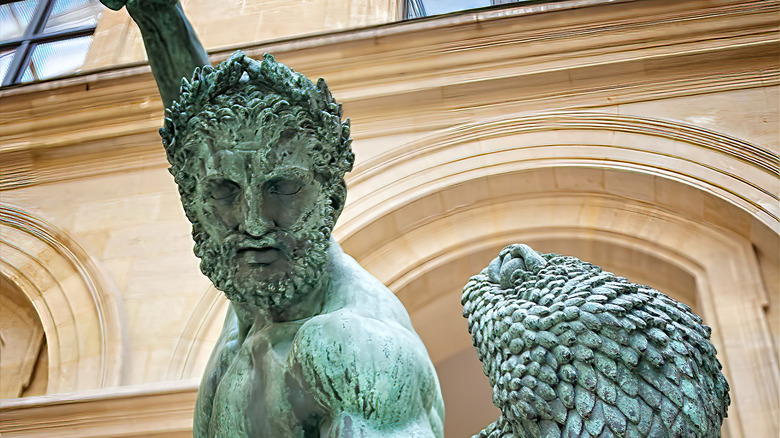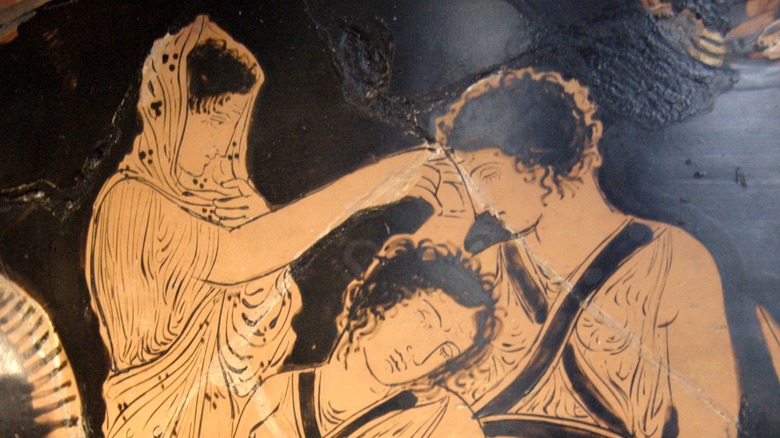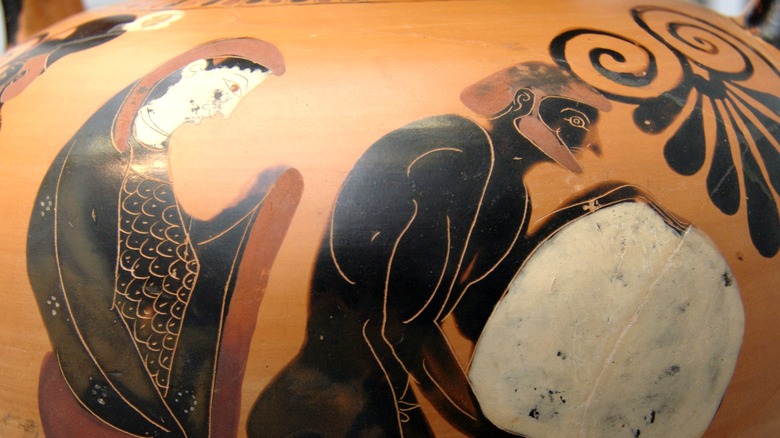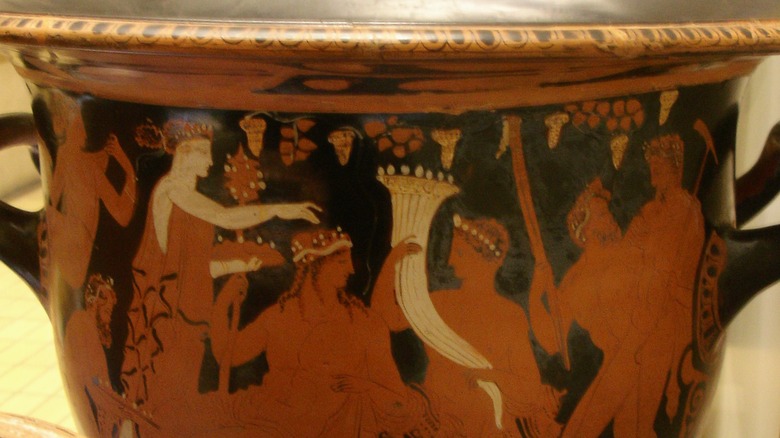The Mythology Of Hades Explained
Hades was the Greek god of the dead, meaning that while he was not the personification of death itself, he ruled over the realm of the Underworld. This included the various afterlives for Greeks: Elysium, Asphodel, and Tartarus. Hades was in charge of a third of the cosmos with his wife Persephone, placed there after drawing the lot for the Underworld when he and his brothers divided up the world, according to Theoi. He was the first-born son of the Titans Cronos and Rhea, and was quite protective of his wife and domain.
But despite his importance, Hades mainly appears in the background of various Greek myths, usually after heroes journeyed to his realm for some purpose, such as attempting to bring a loved one back from the dead. He was known to Greeks as a just god, who appointed judges to see that everyone was treated as they deserved after death. That said, mortals feared to say his name in case of divine consequences.
Overall, Hades is probably most well-known for kidnapping his wife Persephone, but he has more presence than that in Greek mythology. Therefore, let's take a look at the mythology of Hades.
Hades (and his siblings) were eaten as children
Cronos, the Titan of time, and his wife Rhea ruled the universe during a golden age, writes Greek Mythology. They had taken control of the universe away from their own father, Uranus, after he imprisoned some of their mother Gaea's children, the Cyclopes and the Hecatonchires (the Hundred-Handed Ones). Seeking revenge, Gaea convinced Cronos that it would be an excellent idea to castrate his father with a sickle, which he did, casting the remains into the sea.
After the castration, Uranus prophesied that Cronos' sons would overthrow him. So, to prevent this from coming true, he ate all of his children just as they were born, including Hades, his first-born son. After all, a prophecy can't possibly come true if everything has been done to prevent it, right? Hades and four of his siblings — Hestia, Demeter, Poseidon, and Hera — grew up within the confines of their father's stomach. Rhea grew canny when pregnant with Zeus, and hid him away after his birth (via Greek Mythology).
Zeus grew up on Crete, and, unknown to his father, became Cronos' cupbearer. With the Titan Metis' help, Zeus tricked Cronos into drinking a wine and mustard mixture, which caused him to vomit up the rest of his children. Zeus and his now-adult siblings began to coordinate how to wrest power from their father.
War against the Titans
The Titanomachy, otherwise known as the Olympians' war against the Titans, lasted for 10 years. Hades and his five siblings, along with the Titans Prometheus and Thetis, fought against Cronos and the rest of the Titans. Zeus also asked his uncles, the Cyclopes and the Hecatonchires, for help in the war. The Cyclopes created three weapons for the three brothers; Hades received the Helm of Darkness, which he used to great effect during the war (via Myth Craft).
After 10 years, Zeus and his siblings, including Hades, were successful in toppling the old regime on Mount Othrys and establishing a new one on Mount Olympus. Cronos was thrown into the depths of Tartarus, but not before warning his son Zeus that he too would be overthrown by his own child (via Theoi). The other Titans who fought against the Olympians were also jailed in Tartarus, which was now guarded by the Hecatonchires, writes Greek Mythology. With the war over, the six god siblings were free to rule the world as they saw fit.
Drawing the lots of rulership and the Underworld
After the Titanomachy, the three brothers — Zeus, Poseidon, and Hades — drew lots to see who should rule which realm of the cosmos, according to Theoi. Zeus drew kingship over the heavens, while Poseidon drew power over the seas and everything in them.
Hades drew the Underworld, which eventually grew to encompass different afterlives and five rivers. Hades' first act was to appoint a guard dog to his realm, who ended up being a three-headed beast named Cerberus. Cerberus was made up of many animals; he had three dog heads, snakes on his back, and a dragon as his tail. As the dead began to populate the Underworld, the uses of certain rivers became apparent, writes Greek Mythology. Charon, the boatman, rowed dead souls across the River Styx. The River Styx was also used for swearing oaths. It also made people invincible, which Thetis used to great advantage for her son Achilles before the events of the Trojan War to attempt to prevent her son's death (via Greek Mythology). The River Lethe allowed souls to cleanse themselves of the memories they had in life in preparation for reincarnation.
As the ruler of the Underworld, several gods, rivers, and areas fell under Hades' domain. Some were primordial deities, who had already existed since the world began, such as Erebus, the darkness, and Nyx, the night. Lyssa, the goddess of madness, and Hypnos, the god of sleep, also dwelt within the Underworld (via Theoi).
Hades kidnapped his future wife Persephone
Persephone (also known as Kore), the goddess of flowers and spring, was the daughter of Demeter and Zeus. After settling his realm, Hades wanted a wife, so after asking Zeus's permission — but not Demeter's — he kidnapped his niece and brought her down to the Underworld, writes Greek Myths-Greek Mythology. Many myths describe Persephone picking flowers in a field with nymphs nearby when the ground split beneath her feet. A great black chariot heaved itself out of the earth, Hades inside it. Without exiting the chariot, he carried her off to his palace to live with him forever. There is much artwork, both ancient and modern, depicting the moment of Persephone's descent.
Unable to find her daughter and with no idea where she could have gone, Demeter laid waste to the Earth, swearing to let everything and everyone die until her daughter was returned to her. Zeus, spooked by her actually following through on such a devastating threat, eventually demanded that Hades return Persephone to her mother. Hades agreed, but first had Persephone eat six pomegranate seeds so she would have to stay in the Underworld. Zeus, Hades, and Demeter eventually made an agreement that Persephone could stay for six months, but went back to her mother for the other six months of the year.
The judges, Charon, Thanatos, and Hades
Hades was the god of the dead, but he was not death itself, as that role went to Thanatos. Thanatos had wings to carry off the souls he reaped. His main appearance in mythology was when he was tied up by the mortal king Sisyphus so that no one could die (via Britannica). Thus it is made clear that Thanatos didn't simply bring the souls to their rest, he was literally the entity that caused them to die in the first place. Hermes was usually the god who guided the souls down to the Underworld, where they boarded Charon's boat. Ancient Greek funeral practices included coins on top of the eyelids, so the dead could pay the ferryman (via Ancient Origins).
Hades also did not personally sort humans into their afterlives but appointed three judges of the dead to do the task for him: Minos, Rhadamanthys, and Aeacus (via Theoi). All three were Greek kings and were seen as wise and just when they were alive.
Hades, therefore, acted more as an overseer, supervising all the afterlives and interceding when necessary. His time was also taken up by all the heroes and mortals who snuck down to the Underworld hoping to accomplish various tasks.
Men often went to the Underworld to rescue their loved ones
The talented musician Orpheus traveled down to the Underworld to bring back his wife's spirit. She had been bitten by a viper on the day of their wedding, according to most myths, and he wanted her returned (via Theoi). Luckily, Persephone was in residence when this occurred. Orpheus was (according to some myths) the son of the muse Calliope and Apollo, the god of music. He was so skilled that, after an intercession from Persephone, Hades agreed that Orpheus could lead his wife's spirit out of the Underworld as long as he avoided looking behind him until they had both reached the surface. Though given a fair chance, Orpheus failed, and lost Eurydice for a second time.
The god Dionysus similarly went down to bring his mother (or sometimes his wife) back from the dead. The god of wine, unlike Orpheus, was successful, writes Theoi. It is unknown what exactly he bartered with Hades and Persephone to achieve his goal, however. In the Orphic mysteries, Dionysus was once the son of Persephone and Zeus, called Zagreus, and that close relationship is possibly why Persephone allowed him to carry out his desire. His mother Semele and his wife Ariadne were both made immortal on Olympus.
Two heroic idiots tried to kidnap Persephone
Greek heroes Pirithous and Theseus decided to marry daughters of Zeus, feeling that as heroes they should marry women befitting their great stature. Theseus' wife Phaedra had recently died, writes Greek Legends and Myths. Pirithous' wife Hippodamia had also died, possibly in childbirth.
Theseus decided on Helen of Sparta, who was a child at the time, and kidnapped her from her home. He brought her to live in Athens. Pirithous set a higher bar when he decided to kidnap the goddess Persephone, who was known to be loyal, away from her husband Hades. Theseus came along for moral support, and to assist with any obstacles they faced. Pirithous failed badly, and his only achievement was getting himself and Theseus permanently bound to chairs in the Underworld. Theseus was eventually rescued by Hercules, while Pirithous was imprisoned in the Underworld forever as a reminder of his folly: thinking he could take the wife of a god for his own.
Hercules went to Hades' Underworld for quests
Hercules went to the Underworld at least once, but possibly several times, when he was still alive. As a demigod son of Zeus, Hercules was hated by Hera, who cursed him with madness, causing him to kill his family in the process. Grieving, Hercules prayed to Apollo, the god of prophecy, to see what he should do. Apollo advised that Hercules serve King Eurystheus for 12 years as punishment.
One of Hercules' labors during that time required borrowing Hades' three-headed dog, Cerberus, writes ThoughtCo. In preparation for his trip to the Underworld, Hercules was initiated into the Eleusinian mysteries. These mysteries honored Demeter and her daughter Persephone, queen of the Underworld. It was said that those initiated would have happiness in the Underworld. Once there, Hades instructed Hercules that he could take Cerberus as long as he brought the creature under control using only his own strength. Hercules managed this, though he was bitten by the dragon that was part of Cerberus' tail for his trouble. Hercules brought Cerberus to Eurystheus to complete the labor, but then returned him to Hades, writes the Perseus Digital Library Project at Tufts University.
Hercules may have returned to the Underworld at least twice more. During one of his visits, he freed Theseus from his Underworld punishment but was forbidden by Hades from releasing Pirithous. He also rescued the queen Alcestis from Thanatos, which may have happened in the Underworld or possibly in the world above.
Hades' lovers
Hades had two main lovers other than his wife: Minthe and Leuce. Unlike his brother Zeus, Hades was not nearly as promiscuous. Both myths have some variations.
Minthe was a nymph who was loved by Hades. In some versions, she seduced him. Regardless of how it came about, the ending to the affair is the important part. In rage, Persephone, presumably having come to either love her husband or at least harbor feelings of jealousy, turned Minthe into the mint plant. Thereafter, Minthe could only creep beneath people's feet. Mint is also thought to have been used during Greek funerary rites, according to Theoi.
Leuce was a nymph who was brought to the Underworld by Hades and turned into a poplar tree, writes Theoi. In some myths, Leuce was Hades' first wife before Persephone. In others she was only one of his lovers. Poplar trees were therefore sacred to Hades, and were said to grow on the banks of the Acheron river.
Hades' children and servants
Hades had several children with Persephone. He was also the effective father to a few of Zeus' children by Persephone, who was Zeus' daughter. Yes, Greek mythology is very strange.
The goddess of blessed death, Macaria, was one of Hades' daughters by his wife. She is thought to be a lighter, pleasanter version of Thanatos, writes Theoi. She also may have been connected to the afterlife for heroes, Elysium. Melinoe, the goddess of ghosts, was a daughter of Persephone and Zeus. Her coloring was split evenly between ghost white and night black. Melinoe also may have been another of Hecate's names for those initiated into the Orphic mysteries, writes Theoi.
Unlike Zeus and Poseidon, Hades did not have many children. Hades also had servants in the Underworld who obeyed his rule. The Erinyes, otherwise known as the Furies, were three goddesses of vengeance and divine retribution. They were born from Uranus' spilt blood when he was castrated. The Erinyes were mainly concerned with crimes against nature, such as offenses against the gods or homicide, according to Theoi.
Sisyphus was right to be afraid of Hades' wrath
Sisyphus, a mortal king of Ephyra (some myths say he was king of Corinth), attempted to escape death by chaining up Thanatos so that no one could die, including him. Sisyphus had a nasty habit of killing his guests, so Zeus attempted to teach him a lesson by having Thanatos bind him in his own chains. Sisyphus tricked Thanatos as well. Ares, frustrated that no one was dying in his wars, eventually rescued Thanatos and Sisyphus was caught, writes Greek Mythology.
However, he escaped Hades' realm again by instructing his wife to perform his funeral rites incorrectly, so, as he told Persephone, he would have to go back to the mortal realm in the meantime to scold her, writes Theoi. After living out his mortal life, according to some myths, Sisyphus was subjected to pushing a boulder up a hill for all eternity in the aptly named Fields of Punishment. Other myths claim that he was caught soon after he absconded to the mortal realm after the incorrect funeral rites. Mortals thus learned to avoid risking the wrath of Hades, Persephone, or Zeus.
Hades vs. Pluto, and the Underworld
The Romans utilized the ancient Greek gods for their own needs, and renamed most of them for their own religion. Hades' Roman counterpart, Pluto, was more commonly known for being the god of wealth and gemstones. One of Hades' nicknames, "Dis," means "the rich" in Latin. In Greek, it reads as "Plouton." Pluto, therefore, is the Latinization of one of Hades' Greek epithets, and clearly relates to wealth (via ThoughtCo).
Since some Greeks feared to say Hades' name, the Underworld eventually came to be named after him and called Hades. The name of the god was never spoken, though the name of the afterlife was. Pluto is therefore the god of Hades, the place underneath the earth, because all wealth and minerals come from the ground. Therefore, mortals could pray to him without focusing solely on death, writes ThoughtCo.
The nickname Pluto also became popular in Greece thanks to the Eleusinian Mysteries. Pluto was more than the kidnapper of Persephone there but was the protector of the earth's bounty — both above (Demeter's harvests) and below (gems and wealth) the earth.
